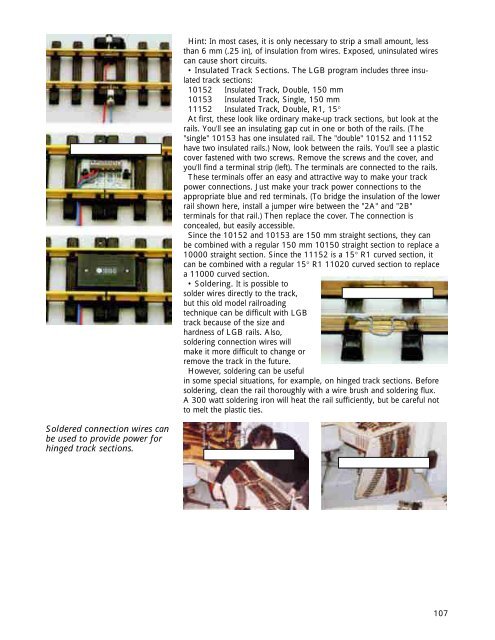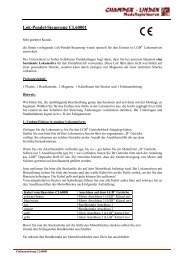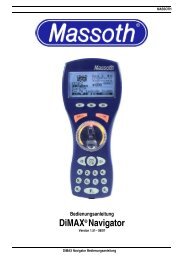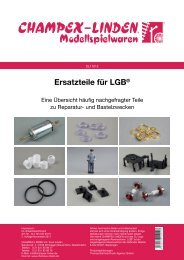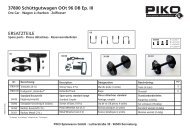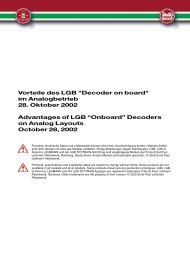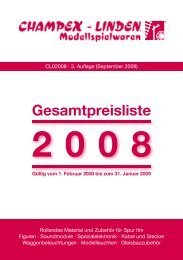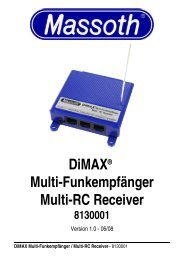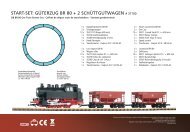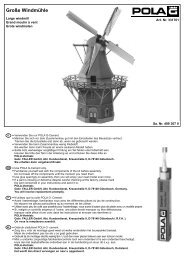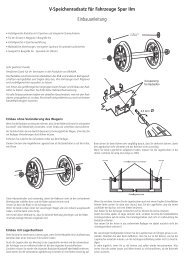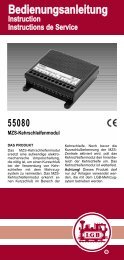00559 Interim PDF Edition - Champex-Linden
00559 Interim PDF Edition - Champex-Linden
00559 Interim PDF Edition - Champex-Linden
Create successful ePaper yourself
Turn your PDF publications into a flip-book with our unique Google optimized e-Paper software.
Soldered connection wires can<br />
be used to provide power for<br />
hinged track sections.<br />
Hint: In most cases, it is only necessary to strip a small amount, less<br />
than 6 mm (.25 in), of insulation from wires. Exposed, uninsulated wires<br />
can cause short circuits.<br />
• Insulated Track Sections. The LGB program includes three insulated<br />
track sections:<br />
10152 Insulated Track, Double, 150 mm<br />
10153 Insulated Track, Single, 150 mm<br />
11152 Insulated Track, Double, R1, 15°<br />
At first, these look like ordinary make-up track sections, but look at the<br />
rails. You'll see an insulating gap cut in one or both of the rails. (The<br />
"single" 10153 has one insulated rail. The "double" 10152 and 11152<br />
have two insulated rails.) Now, look between the rails. You'll see a plastic<br />
cover fastened with two screws. Remove the screws and the cover, and<br />
you'll find a terminal strip (left). The terminals are connected to the rails.<br />
These terminals offer an easy and attractive way to make your track<br />
power connections. Just make your track power connections to the<br />
appropriate blue and red terminals. (To bridge the insulation of the lower<br />
rail shown here, install a jumper wire between the "2A" and "2B"<br />
terminals for that rail.) Then replace the cover. The connection is<br />
concealed, but easily accessible.<br />
Since the 10152 and 10153 are 150 mm straight sections, they can<br />
be combined with a regular 150 mm 10150 straight section to replace a<br />
10000 straight section. Since the 11152 is a 15° R1 curved section, it<br />
can be combined with a regular 15° R1 11020 curved section to replace<br />
a 11000 curved section.<br />
• Soldering. It is possible to<br />
solder wires directly to the track,<br />
but this old model railroading<br />
technique can be difficult with LGB<br />
track because of the size and<br />
hardness of LGB rails. Also,<br />
soldering connection wires will<br />
make it more difficult to change or<br />
remove the track in the future.<br />
However, soldering can be useful<br />
in some special situations, for example, on hinged track sections. Before<br />
soldering, clean the rail thoroughly with a wire brush and soldering flux.<br />
A 300 watt soldering iron will heat the rail sufficiently, but be careful not<br />
to melt the plastic ties.<br />
107


